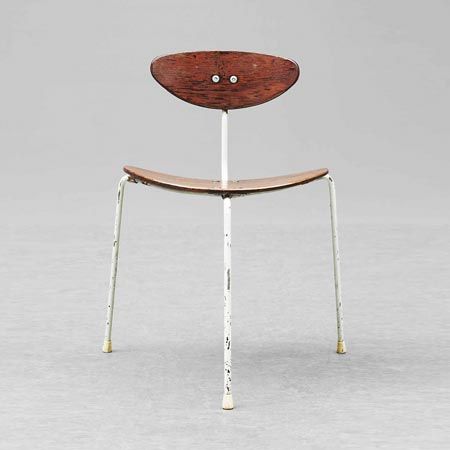
Ernest Race 1913 – 1964.
The furniture designed by Ernest Race was a dominant feature at the Festival of Britain’s Southbank site on the Thames. Race, an innovative designer, formed Ernest Race Ltd with engineer Noel Jordan in 1945. Located in Clapham, the small company set about the challenge of producing furniture designs in a time of post-war restrictions.

BA Dining Chair, 1946. Designed by Ernest Race.
In 1946, Race launched the BA Chair (see pic) “made from re-purposed aluminium from redundant aircrafts. The seat covering was originally made from ex-RAF parachutes in a lightweight white cotton. The chair was exhibited at the ‘Britain Can Make It’ exhibition at the Victoria & Albert Museum” (racefurniture.com). But it would be the Festival of Britain in 1951 that would bring Race’s designs to the attention of the nation. Race’s ‘Antelope’ and ‘Springbok’ chairs (see pic), which could be used indoors or outdoors, were a prominent feature on the Southbank terraces. Race also used the event to launch his ‘Roebuck’ stacking chair.
‘Antelope’ (left) and ‘Springbok’(right) Chairs at Festival of Britain, Southbank site on Thames, London, 1951.
The Festival of Britain was featured in Australian newspapers and lifestyle magazines, and attended by young Australian architects and designers keen to see the best of British Design. The Springbok chair, not put into production after the festival, proved irresistible to Adelaide company Tubular Steel Industries (TSI) who produced a copy of the chair, renaming it the ‘Jumbuk’ chair. Australian designer Fred Lowen visited England in the early 1950s to conduct design research for his fledgling furniture company FLER.

Aluminium Shell Chair, 1953. Designed by Fred Lowen for FLER, Melbourne.
It’s possible that the Fler Aluminium Shell Chair (1953) was inspired by Race’s innovative use of aluminium in his furniture designs. In Lowen’s case, the material and processes proved too expensive, leading to a small production run of the chair. Now making the FLER chair a rare and highly sought after design.

Unicorn Chair, c.1958. Designed by Ernest Race.
In his short career, Race died in 1964, Ernest Race produced some of the most innovative furniture designs of the period. His understanding of materials and industrial processes was arguably central to his problem solving abilities and unbridled creativity. Of all his designs, it is the simplicity and sculptural qualities of the 3 legged ‘Unicorn’ chair (see pic) that I have long admired. It is the physical manifestation of an idea, a meditation in steel rod and moulded ply. For me, this is the moment when design and art combine to make something that is more than its materiality
Isokon Book Donkey Mark l, 1939, designed by Egon Riss. Isokon Book Donkey Mark ll, 1963, designed by Ernest Race.
For now, I feel lucky to have an original ‘Book Donkey Mark ll’ designed by Race for Isokon in 1963, a reinterpretation of ‘Book Donkey Mark l’ designed for Isokon by Egon Riss in the late 1930s. The Festival of Britain continues to inspire me, and in these times of social-distancing and self-isolation I have looked to this event and drawn inspiration and comfort from the unflinching optimism and resilience of post-war Britain. Thank you for sharing my Festival of Britain journey this week, and thank you to all those who design, make and create; because life is so much more than an economy. It’s nice to know that Race Furniture Ltd continue to produce many of Ernest Race’s iconic mid-century designs.



